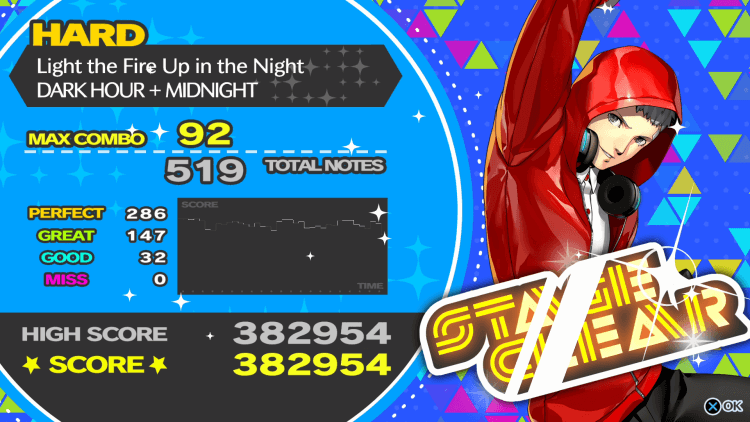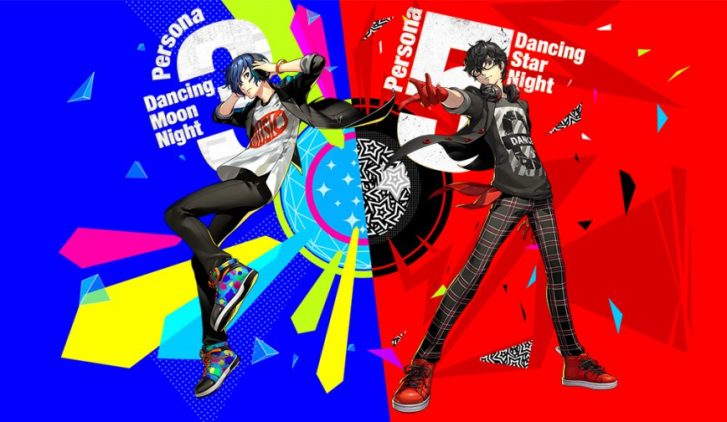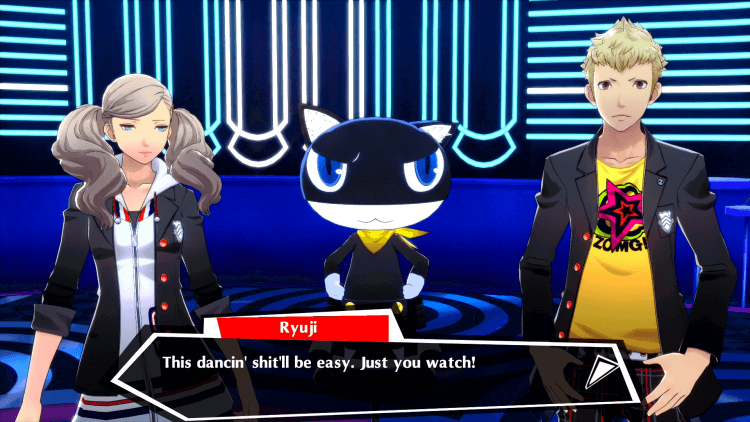And what comes next, hey, bust a move
Let’s get this out of the way. If you played Persona 4: Dancing All Night, then you know what to expect here. If you didn’t, then welcome an enjoyable rhythm-based game where you’ll jam away to music found in Persona 3 and 5. Tap some buttons, earn some cool stuff, all while enjoying yourself. That’s what this is all about.
Game Name: Persona 3: Dancing in Moonlight/Persona 5: Dancing in Starlight
Platform(s): PlayStation 4 (reviewed), also available on PS Vita
Publisher(s): Atlus
Developer(s): Atlus
Release Date: December 4, 2018 (North America)
Price: $99.99 for the Persona Dancing: Endless Night Collection, $39.99 for each game separately
This review is a bit different as we’re reviewing two games at once. Why? Well, because outside of their presentation and song selection, they’re the same game. Both Persona 3: Dancing In Moonlight & Persona 5: Dancing In Starlight are provided in the Persona Dancing: Endless Night Collection, which is what we were provided with for this review. As such, we’re treating them as one game.
Welcome to Club Velvet
If you’ve played the previous entry, get ready for some changes in Persona 3: Dancing In Moonlight & Persona 5: Dancing In Starlight. Specifically with the story mode that; that’s gone completely. Replacing it is a new mode called “Social”. It’s here that you’ll revisit often whenever you manage to hit an accomplishment, such as hitting a score threshold, getting a number of perfects or using modifiers. Once you access this mode, you’re provided a selection of your characters and you’ll be shown who has unlocked what. Select a character and you’re treated to a dialogue between you and the character. You’ll also have the chance to interact with them via question. Sadly, the answer you provide doesn’t really provide a bearing on the conversation and instead just provides with some amusement on your part. Where the story mode in Persona 4: Dancing All Night provided you with new items and clothing for your characters, this all happens within this mode.
Oddly enough, there’s also no villain to be had in either game. Which makes sense since the story mode is gone and that neither games are part of Persona’s canon. The only reason you’re here is that you’ve been hijacked in your dreams and forced to dance thanks to a sibling affair. That’s it, no other reason than you enjoy a night in the velvet room, er… club velvet. Truth be told, the removal of the story mode isn’t a bad thing. In fact, this means there’s just one game mode now. I’m sure Atlus figured out that the majority of people who played Persona 4: Dancing All Night, just wanted to jump straight into the dancing. Which is exactly what you do here. You can even ignore the social aspect completely and you’ll still finish the game. Sure, you’ll miss out on some interesting stuff, but it’s still possible. That said, I don’t recommend doing so, or you’ll miss out on some interesting items and the charm of the game.
Progression works by clearing the easy, normal and hard versions of songs. Do well, and soon enough you’ll unlock all the songs. The gameplay is really easy to get a grasp of but takes a bit of skill to start nailing those perfects on a constant basis. Throughout the songs being played, you’re tasked with tapping the corresponding button while a note passes through that button. Tap it perfectly and you’ll score a perfect while doing so too early or too late will result in a great or good score. Miss them completely or press the wrong button will provide with a negative miss score (you don’t want those). Toss in some other variables such as scratches if you’re feeling fancy to push your score over the top. Or activate the modifiers to make your game a bit easier or harder.
You’ll create combos with perfects and greats, while good and misses will drop them; unless you have an item that forgives an accident or two. The longer the combo, the bigger the score. Ultimately, your job is to not let the audience get bored of your performance which is indicated via a meter. Keep them happy and you’ll do well. Should you exceptionally good, you’ll score a frenzy, which lets a partner jump into your dance with you for a short while. While this is active, you’ll get new dancing combinations. Initially, you’ll have a default partner. But as you play, you’ll unlock more of them and can then choose which one you can dance with.
That said, I found the easy mode, well, too easy. That goes double for the normal versions of the songs. The only real challenge was the hard renditions and even those weren’t as challenging as I wanted. Thankfully that’s where the modifiers come in, as well as increasing the speed of the notes as they whiz by on the screen. Of course, once I smashed the final song on hard, another challenged appeared. That’s right, the “All Night” difficulty is back and to say that it’s just as challenging as it was in Persona 4: Dancing All Night is an understatement. I’m still trying to make it through all the songs without dropping a note.
Let’s talk about what makes and breaks this game; the music and those fantastic dances. Fans of the Persona series will enjoy the number of tracks that are present in the game. Lots of familiar songs make their way into the games, such as fan favorites ‘Mass Destruction’, ‘Life Goes On’, ‘ Rivers in the Desert’ or ‘Last Surprise’, to name a few. In addition to those tracks is a large assortment of remixes which range from amazing to so-so. It’s nice to see that the original arrangements are still available, as I did enjoy those a bit more than several of the remixes. As for the dances, well, some of them are a bit off the wall. Nothing short of waving of hands and legs into silly positions, so much that I’d hardly call it dancing. Then again, I suppose that’s the charm of the game.
I did encounter some issues with timing. There were a few songs where it was a bit off key and it did cost me a few perfect results. Try as I may, every time I went through that specific song, the beats didn’t line-up properly and it got frustrating. It’s not game-breaking, but it is annoying. It’s also worth noting that the game does spoil the ending theme and credits for Persona 5. So if you happen to be playing that game, you may want to skip out on playing Persona 5: Dancing In Starlight. That is if that bothers you.
And yes, for those wondering. You can change the voices from English to Japanese, or turn them off completely. That includes the voices from the crowd that is cheering you on. Which is a godsend as they do tend to get repetitive over time. Just shut up and let me dance, dang it! As for the visuals, the game is impressive. Both games retain the same art style that was introduced in both Persona 3 and Persona 5. It’s vivid, the animation is top tier and damn if it doesn’t look good. Sadly, it does appear that they reused a lot of the animation, which is apparent the more you play the game.

What about Persona 4: Dancing All Night?
Ah, yes, while we’re at it, let’s talking about Persona 4: Dancing All Night. Atlus’s first go at combining the popular Persona series with a rhythm dancing game. Still the best game out of the entire dancing series in my eyes. However, unless you pick up the vastly more expensive Persona Dancing: Endless Night Collection, you won’t get access to the game. Instead, this is Atlus basically putting a fan favorite behind a paywall and demanding you shell out the cash for it. A bad business decision if I ever saw one. Why not offer this as a standalone for those who want to play it on the PlayStation 4?
For now, if you want to play Persona 4: Dancing All Night, you have to purchase the Persona Dancing: Endless Night Collection. At the time of this review, Atlus has no plans to release this as a single title and that’s disappointing. That hurts as not only does it include some great remixes. But it retains the story mode is currently the only way to play the game on the PlayStation 4. Hopefully, they’ll change their minds about this.
Check out our review of that title, here.
Is this for you?
In the end Persona 3: Dancing In Moonlight & Persona 5: Dancing In Starlight is nothing more than fan service. Glorious fan service! You, the SEES and the Phantom Thieves, lots of enjoyable music, all of which makes for a fantastic way to chill. The game doesn’t take its self seriously and there’s a lot of charm and stylish presentation going on here. While both games are really short, it makes it up it in replay value. Not only will it take some time to clear the harder songs with perfect accuracy. You’ll also have to unlock all the characters if you truly want to finish the game in its entirety. I feel it’s the perfect game and a good alternative from slaying monsters, landing headshots or handing down beatdowns (or receiving them). If you just run through the dancing modes, you’ll beat each game in about 3 hours. Doing so, you’ll miss out on a lot of content which extends the playtime of the game. That said, there’s only such much you can do in the end, short of trying to get perfects on every song.
The only concern I have is the price of admission. Sure, for $99 you can score the Persona Dancing: Endless Night Collection. Or you can pick up either Persona 3: Dancing In Moonlight or Persona 5: Dancing In Starlight, separately and considerably cheaper. There’s not really a big difference between the games offered. In the end, it’s going to come down to how much you enjoy the characters and atmosphere of the games. Which is concerning as I don’t feel there’s enough here to warrant a purchase both games – unless you’re a diehard fan of the series.
Review Disclosure Statement: Persona Dancing: Endless Night Collection was provided to us by Atlus for review purposes. For more information on how we review video games and other media/technology, please go review our Review Guideline/Scoring Policy for more info.
Affiliate Link Disclosure: One or more of the links above contain affiliate links, which means at no additional cost to you, we may receive a commission should you click through and purchase the item.
Summary
Persona 3: Dancing in Moonlight/Persona 5: Dancing in Starlight serves up a heaping portion of fan service, enjoyable tunes and provides a nice amount of entertainment. Both titles appeal to fans of the Persona series, thanks to fan favorites busting a move on the dance floor. Fun, simple and a game that doesn’t take its self too serious. Perfect for gamers who just want to relax and dance the night away, virtually that is.
Pros
- Lots and lots of fan service
- Familiar tracks from both Persona 3 and 5
- Lovely visuals
- Lots of stuff to unlock if you don’t rush through the game
Cons
- Both games are similar, way too similar
- Some tracks have timing issues which may mess with your mind
- Persona 4: Dancing All Night is only included with Persona Dancing: Endless Night Collection




